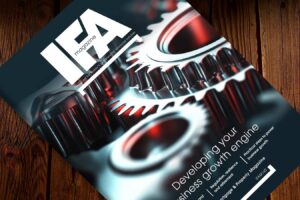Global markets have plunged further this week, with the FTSE 100 index about 5% since the Monday open.
Brief hopes of some stabilisation yesterday as the FTSE 100 rebounded were dashed as yet more red appeared on Wall Street screens, with the S&P 500 index on the edge of bear territory and the Footsie falling further today.
Moreover, the 30-year UK gilt yield has surged to its highest since 1998, after U.S. Treasury yields soared: it has hit 5.64%, pushing well past a previous multi-decade high of 5.472% set in January.
Gary Smith, Financial Planning Partner and retirement specialist at wealth management firm Evelyn Partners, says: ‘Market crashes like this will be unnerving many more people than they used to because the decline of defined benefit pension schemes in the private sector and auto-enrolment have turned most employed workers in the UK into investors.
‘Most in the private sector will be in defined contribution pension schemes, and many of those will be in the default fund, which will usually be a mixture of equities and bonds. While share markets have born the brunt of Trump’s tariff bombshells, bond markets are also gyrating.
‘The self-employed will be more likely to have a personal scheme like a stakeholder pension or a self-invested personal pension (SIPP), and depending on how they have invested their contributions, they are likely also to see sharp falls in the “paper value” of their pot.
‘Some savers might be looking at their pension account, seeing red, and panicking a bit – but for many defined contribution pension holders who don’t need to access their pension savings in the near future, there is little jeopardy at the moment and no need to make changes.
‘They should mostly avoid messing around under the bonnet of their pensions while there are lots of moving parts, as it can just lock in losses. In fact they can take a bit of comfort in that their regular monthly contributions will be picking up cheaper investments.
‘We have seen time and again that shocks hit equity or bond markets in the short or medium term, but that in the long term they recover.’
IMPLICATIONS FOR PENSION SAVERS
Defined benefit pension schemes
Smith says: ‘Defined benefit pension holders should be largely unaffected as their payouts are mostly fixed and guaranteed.
‘But with bond markets as well as equity markets in turmoil this week, some DB scheme member might be having unpleasant flashbacks to the gilt market rout in late 2022 and early 2023 that followed the Kwarteng-Truss mini-Budget.
‘A replay of the leveraged liability-driven investment (LDI) crisis which the September ‘22 mini-Budget had a hand in causing – by enflaming already rising gilt yields – seems unlikely as DB schemes took steps in the wake of that scare to adjust their strategies.
‘Even in that eventuality, however, savers are heavily protected and it would take quite an extreme turn of events for there to be any concern on the part of DB scheme members.’
Defined contribution and personal pension holders
Smith says: ‘It’s often said at times like this that it’s those “on the verge of retirement” who worry most but more accurately it’s those who were on the verge of accessing pension funds. After all, some people take their 25% tax-free cash as a lump sum when they are still working – to pay down the mortgage, for instance – and continue to earn and pay into their pension for another 10 years.
‘Some people retire and don’t need to access their pension cash straight away. Some have a very set date as to when they want to stop working and start using their pension, while for some it’s a very moveable feast.
‘People in these different situations can and will react differently to market crises like we’re seeing now – but in many instances advice from a financial planning or investment professional can be invaluable, as one thing the current cataclysm demonstrates is that retirement planning is not easy in the age of defined contribution pensions where savers take the investment risk and must decide how to access their funds.
‘For instance, the Autumn Budget announcement that unused pension assets will be included in inheritance tax liabilities from April 2027 has prompted many savers to think about drawing down on their pensions earlier and more aggressively than they had envisaged – because it will no longer be so tax-efficient to leave substantial pension assets at death.
‘Those plans could now be upended by this turmoil because drawing down on pension funds currently might involve selling investments at sharply lower valuations than just a few weeks ago. For some elderly savers, who don’t know how long it will take for their investment valuations to recover, they could feel like they are between a rock and a hard place.
‘Potentially complex investing, tax and cash-flow decisions are in play, not least – for those who are accessing their pensions – in the sequencing of how all savers draw down on their pot.
‘So yes, someone who was about to take money out of their pension pot and has it all in equities will not be in a great position at the moment, as if they go ahead with their plan they will be locking in investment losses. They would ideally delay the withdrawal but while it may not be much help to them now, the key is not to be in that position in the first place.
‘Some will have to change their plans – for instance, if they had been planning to take their 25% cash-free lump sum to pay down the mortgage they might have to put that off, unless of course they had switched their investments before the recent correction to prepare for this. There might even be some people, reliant on their pensions for an income in a retirement they had wanted to begin shortly, who decide to work a bit longer and let their pot recover.
‘What those a bit earlier in their savings phase can learn from events like this is that market volatility does occur now and again and there are steps that can be taken to lessen the impact if it should happen in the future when they are on the verge of retirement.’
SOME PENSION TIPS
Gary says: ‘As noted, retirement planning can be a complex discipline, and those building up significant pots should take advice. But there are some principles those determined to go it alone can take on board.
‘None of the below can be applied to everyone as it will depend on whether you are in the accumulation or drawdown phase, and the optimal approach will vary according to your overall financial situation and what assets you hold outside, as well as within, your pension arrangements – as well of course on any plans you might have in terms of leaving an inheritance.’
- Don’t be afraid of investment risk – but be aware of it
‘It can be tempting to reduce risk dramatically across the whole pension pot if you think you need to access cash and/or retire shortly. But maintaining investment exposure is often essential for long-term sustainability, as equity markets have always tended to produce better returns than most other investable asset classes over the long term.
‘As many more of us are living well into their nineties, and as some of us are looking to retire early, the prospect of a 40-year retirement is not unthinkable. Most people will not have a pension pot that is big enough to take risk off the table entirely and still provide an income for that length of time.
‘As a result, many retirees will typically be advised to remain invested in a well-diversified portfolio through retirement, one that includes a mix of equities, bonds, and alternative assets. This gives you the flexibility to adjust income levels and respond to changing market conditions.’
- Beware “sequencing risk”
‘One of the biggest risks to your retirement is not just how markets perform, but when. Sequencing risk refers to the danger that early losses in retirement, combined with withdrawals, can do lasting damage to your portfolio as you are selling down investments for withdrawals when prices have fallen.
‘For example, if markets fall in the early years of retirement and you’re withdrawing income at the same time, you could lock in those losses, reducing your capital base and limiting future recovery.
‘Mitigating sequencing risk means planning ahead, keeping a cash buffer, keeping other funds invested for long-term growth. Having different portions of your pension pot, and other savings and assets outside it, means you can be flexible with withdrawals, and adjust to market conditions.’
- Keep a cash buffer – as well as “derisking” ahead of significant pension withdrawals
‘As well as the standard financial advice of keeping an emergency buffer of around 6–12 months in cash savings, it can also be advisable to build up a cash-equivalent portion within one’s pension if you are thinking of accessing your pension in the next few years.
‘For instance, someone who wants to take their 25% tax free cash as a lump sum, will probably want to make sure that they stabilise a portion of their pot by steadily switching it into stable cash-equivalent funds well in advance.
‘Moreover, for someone thinking of retiring and using their pension for income, we would recommend up to two years of additional income shortfall in cash or cash-equivalent to ride out exactly the sort of circumstances we are seeing right now.
‘In each case, liquidity will cover unexpected costs without tapping into your investments. Those who have assets outside of their pension, can pause or reduce pension withdrawals during market downturns. Either way, the aim is to avoid being a forced seller at the wrong time.
‘For some a good strategy can be to split your pension savins into a number of portions. Some earmarked for short term spending, others for capital expenses in the medium term (new cars, major holidays), and another for long term investment. Taking a different risk approach for each of these pots can maintain growth prospects while avoiding the need to sell down assets at the wrong time.’
- Don’t be rigid with withdrawals
‘A rigid, fixed-income approach can be risky during periods of volatility. Instead, consider a dynamic withdrawal strategy that adjusts based on market performance and your spending needs.
‘For instance, you might withdraw a set percentage – rather than a set monetary amount – of your portfolio each year, allowing for some flexibility. In years of strong market returns, you can afford to take more. In weaker years, drawing less can help give your investments time to recover.
- Diversification
‘It might look like we are in a bit of a perfect storm at the moment, with bond markets also hit this week on top of equity price plunges. Historically, with an exceptional period in 2022, bonds have helped to balance equities in a portfolio both by being less volatile and also by tending to move in the opposite direction, helping to offset stock market volatitily.
‘There’s currently no reason to expect this won’t be the case in the future but those concerned about how to diversify should seek advice from a professional. For those who don’t want to, the stablished wisdom is that a well-diversified portfolio which remains your best defence against volatility.
‘Spreading your investments across asset classes, sectors, and regions can help reduce the impact of any single market shock. Ready-made portfolios – which usually offer a range of risk approaches – multi-asset funds, and dedicated pension-related funds (which many savers in DC schemes will be automatically directed into) can help to achieve this without extensive investment choices.
‘DIY pension pot investors should review their asset allocation regularly, particularly as they approach or enter retirement.’
Annuities
Gary says: ‘Not everyone devotes the whole of their pension pot to drawdown. With improvements in annuity rates in the last few years of higher bond yields and interest rates, more savers are choosing to use some of their pension pot to buy an annuity, as incomes on offer have risen.
‘Those thinking of buying an annuity can be subject to a certain amount of sequencing risk as they will probably have to sell investments to buy the annuity.
‘Traditionally, before pension freedoms, a pension pot would move into bonds to buy an annuity, with any falls in bond prices offset by rises in annuity rates. Now, DC pension scheme holders getting towards the end of their accumulation stage could have their pension invested in many different strategies depending on what sort of choices they have made, and whether they remained in the scheme’s default fund for instance.
‘As with someone thinking of taking their tax-free lump sum, now might not be the best time to sell investments to fund an annuity purchase, unless preparations have been made to put a portion of their pot into cash-equivalent funds.
‘But there is also some uncertainty around interest rates, with many analysts expecting central banks to cut interest rates as recession fears grow. That could presage a fall in annuity rates from current levels.’
Gary concludes: ‘For the majority who are not confident with managing investments, the current events are a reminder that ongoing advice can provide a great deal of security and some peace of mind. Particularly if a substantial pot is being built up, and even if retirement is far on the horizon.
‘Even for those who want to go it alone for most of their working life when they are accumulating funds into their pension, advice can be hugely beneficial when it comes to decisions on how to plan their retirement.
‘These include how to invest their growing pot during accumulation, how to access it for the first time and through their retirement, and how to manage the pot as they draw down on it.’















